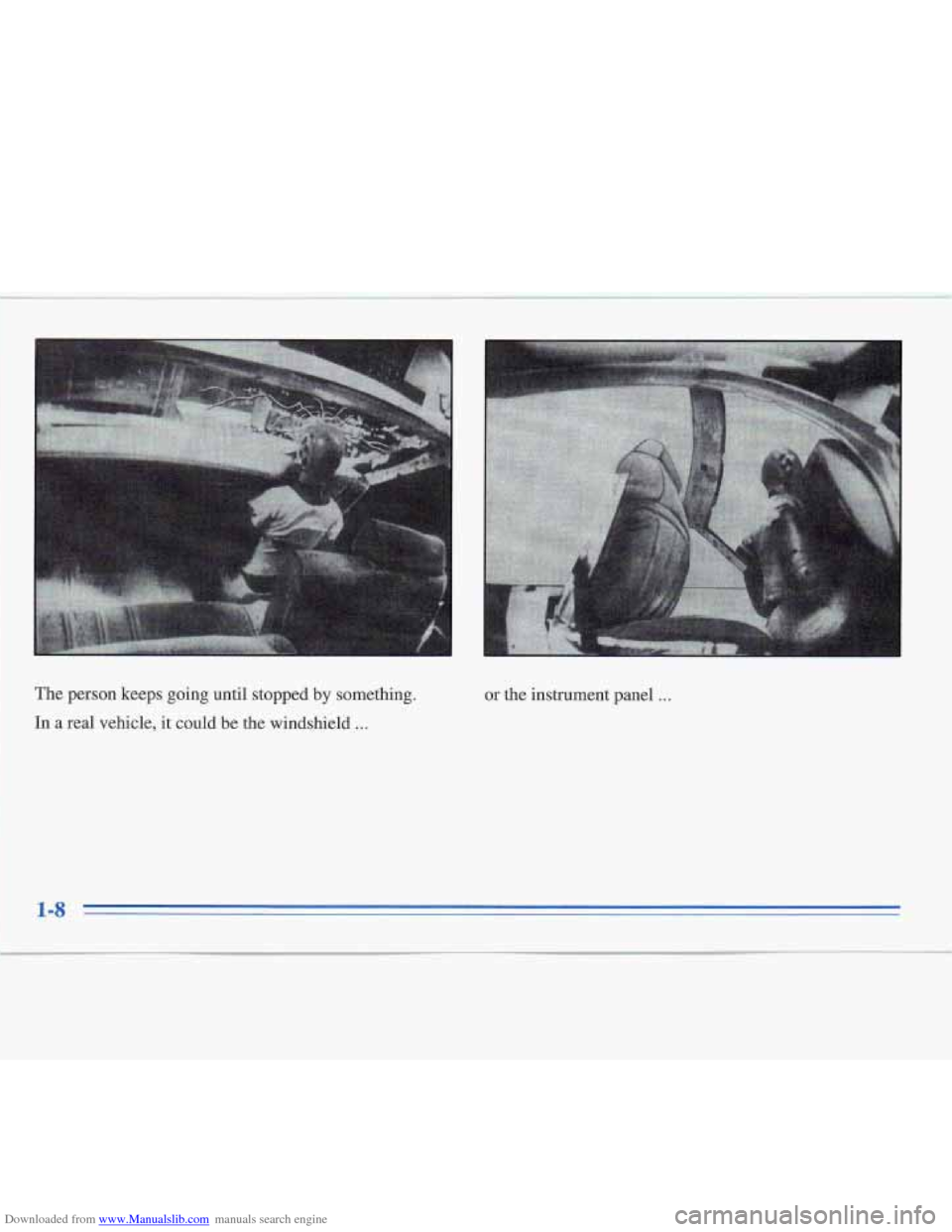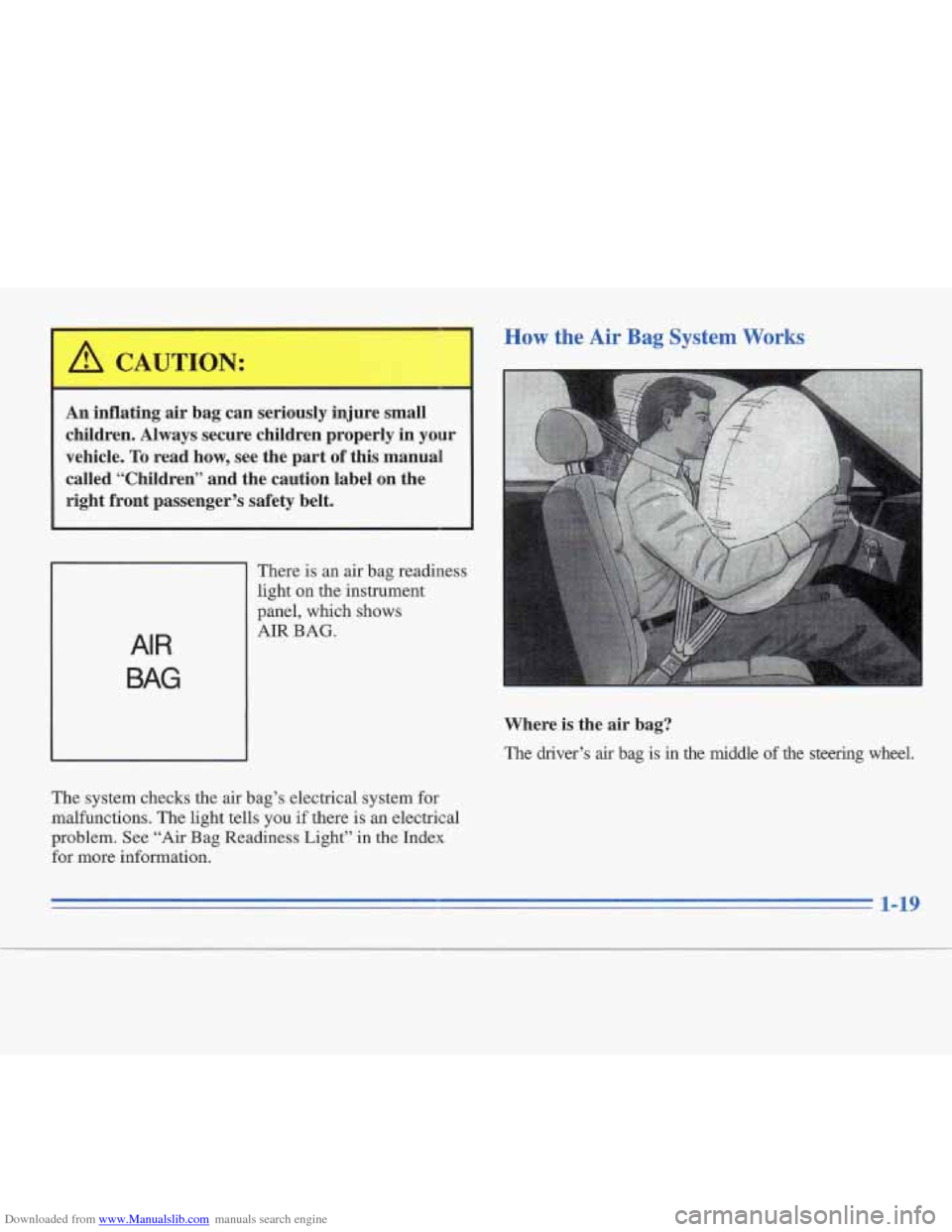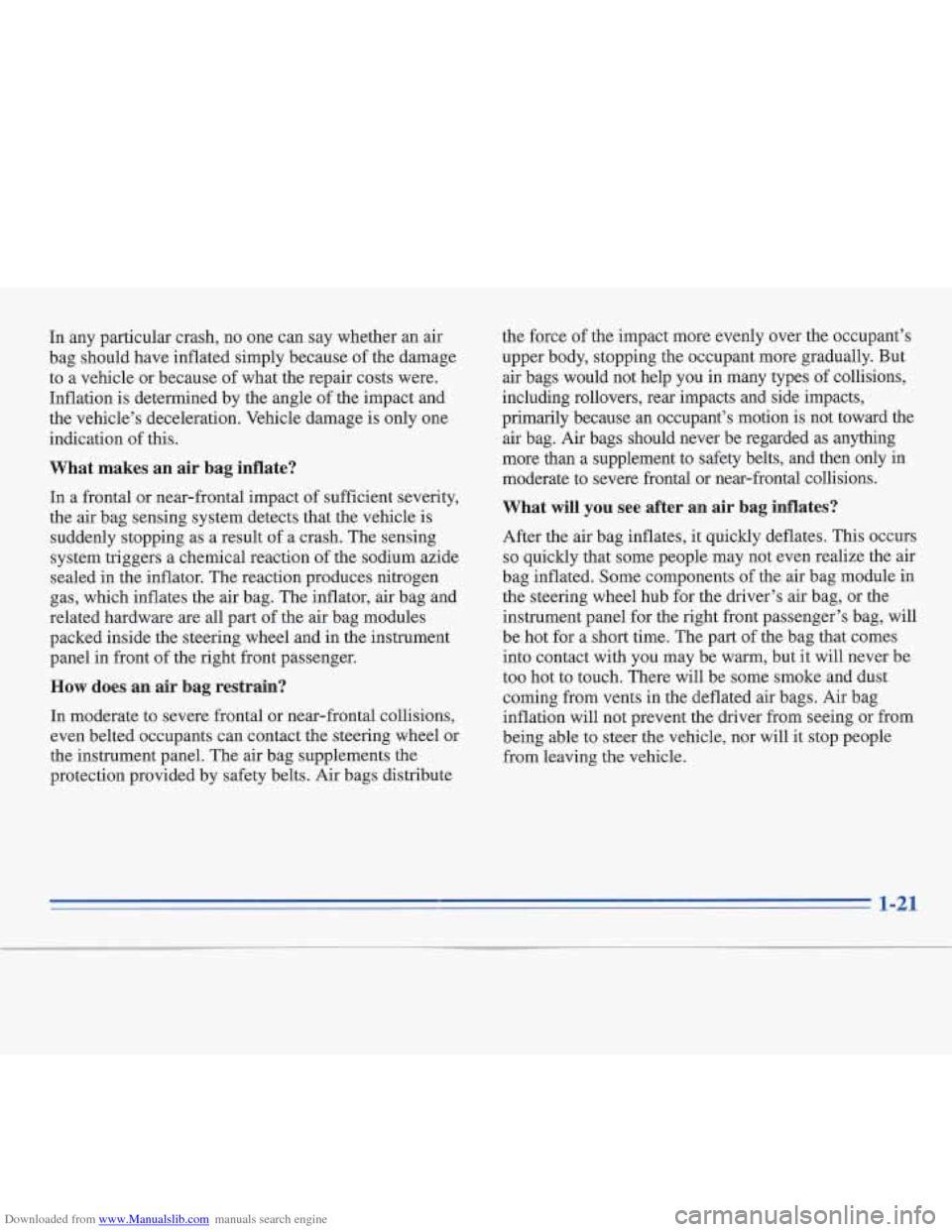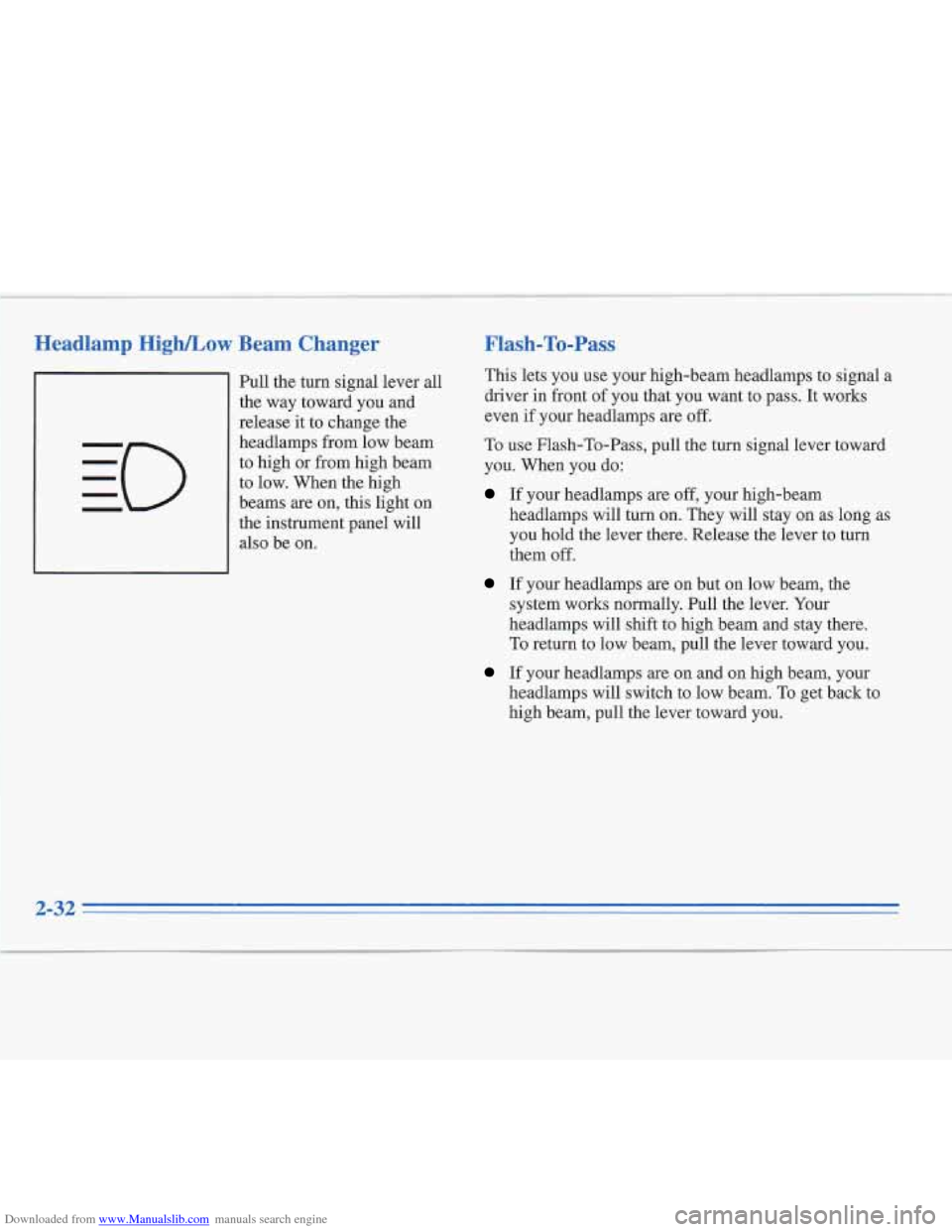1996 CADILLAC FLEETWOOD instrument panel
[x] Cancel search: instrument panelPage 23 of 306

Downloaded from www.Manualslib.com manuals search engine The person keeps going until stopped by something.
In a real vehicle, it could be the windshield ...
or the instrument panel ...
1-8
c
Page 34 of 306

Downloaded from www.Manualslib.com manuals search engine An inflating air bag can seriously injure small
children. Always secure chiIdren properly in your
vehicle.
To read how, see the part of this manual
called “Children” and the caution label
on the
right front passenger’s safety belt.
AIR
BAG
There is an air bag readiness
light
on the instrument
panel, which shows
AIR
BAG.
The system checks the air bag’s electrical system for
malfunctions. The light tells you if there is an electrical
problem. See “Air Bag Readiness Light” in the Index
for more information.
How the Air Bag System Works
Where is the air bag?
The driver’s air bag is in the middle of the steering wheel.
1-19
Page 35 of 306

Downloaded from www.Manualslib.com manuals search engine Don’t put anything on, or attach anything to, the
steering wheel or instrument panel.
Also, don’t
put anything (such
as pets or objects) between
any occupant and the steering wheel
or
instrument panel. If something is between an
occupant and an air bag, it could affect the
performance of the
air bag - or worse, it could
cause injury.
When should an
air bag inflate?
The air bag is designed to inflate in moderate to severe
frontal or near-frontal crashes. The air bag will inflate
only if the impact speed
is above the system’s designed
“threshold level.”
If your vehicle goes straight into a
wall that doesn’t move or deform, the threshold level is
about
9 to 15 mph (14 to 24 km/h). The threshold level
can vary, however, with specific vehicle design,
so that
it can be somewhat above or below
this range. If your
The
right front passenger’s air bag is in the instrument
panel on the passenger’s side.
vehicle strikes something that will move or deform, such as a parked car, the threshold level will be higher. The
air bag is not designed
to inflate in rollovers, side
impacts or rear impacts, because inflation would not
help the occupant.
1-20
Page 36 of 306

Downloaded from www.Manualslib.com manuals search engine In any particular crash, no one can say whether an air
bag should have inflated simply because of the damage
to a vehicle or because of what the repair costs were.
Inflation is determined by the angle of the impact and
the vehicle’s deceleration. Vehicle damage is only one
indication of this.
What makes an air bag inflate?
In a frontal or near-frontal impact of sufficient severity,
the air bag sensing system detects that the vehicle is
suddenly stopping as a result of a crash. The sensing
system triggers a chemical reaction of
the sodium azide
sealed in the inflator. The reaction produces nitrogen
gas, which inflates the air bag. The inflator, air bag and
related hardware
are all part of the air bag modules
packed inside the steering wheel and in the instrument
panel in front of the right front passenger.
How does an air bag restrain?
In moderate to severe frontal or near-frontal collisions,
even belted occupants can contact the steering wheel or
the instrument panel. The air bag supplements the
protection provided by safety belts. Air bags distribute the force
of the impact more evenly over the occupant’s
upper body, stopping the occupant more gradually. But
air bags would not help you
in many types of collisions,
including rollovers, rear impacts and side impacts,
primarily because an occupant’s motion is not toward the
air bag.
Air bags should never be regarded as anything
more than a supplement to safety belts, and then
only in
moderate to severe frontal or near-frontal collisions.
What will you see after an air bag inflates?
After the air bag inflates, it quickly deflates. This occurs
so quickly that some people may not even realize the air
bag inflated. Some components of the air bag module in
the steering wheel hub for the driver’s air bag, or the
instrument panel for
the right front passenger’s bag, will
be hot for a short time. The part of the bag that comes
into contact with you may be warrn, but it will never be
too hot to touch. There will be some smoke and dust
coming from vents in the deflated air bags. Air bag
inflation will not prevent
the driver from seeing or fiom
being able to steer the vehicle,
nor will it stop people
from leaving the vehicle.
1-21
Page 37 of 306

Downloaded from www.Manualslib.com manuals search engine ,;A 1 .’. , . . :AU$ZON:
‘U ‘r, ’? ’, ,~ c- ,,
,-,A . , , - ., ,-. , p, <, ;i 7 ~ - ~~~~~ ~~ ~ ~
When an air bag inflates, there is dust in the air.
This dust could cause breathing problems for
people with a history of asthma
or other
breathing trouble.
To avoid this, everyone in the
vehicle should get out as soon as
it is safe to do so.
If you have breathing problems but can’t get out
of the vehicle after an air bag inflates, then get
fresh air by opening
a window or door.
In many crashes severe enough to inflate an air
bag, windshields are broken by vehicle deformation.
Additional windshield breakage may also occur from
the right front passenger air bag,
The air bags are designed to inflate only once. After
they inflate, you’ll need some new parts for your air
bag system.
If you don’t get them, the air bag system
won’t be there to help protect you in another crash.
A new system will include air bag modules and
possibly other parts. The service manual for your
vehicle covers the need to replace other parts.
Your vehicle is equipped with a crash sensing and
diagnostic module, which records information about
the
air bag system. The module records information
about the readiness of the system, when the sensors
are
activated and driver’s safety belt usage at deployment.
bag system. Improper service can mean that your
air bag system won’t work properly. See your dealer
for service.
Let only qualified technicians work on your air
NOTICE:
~ ~~~~~~
If you damage the cover for the driver’s or the
right front passenger’s air bag, they may not
work properly. You may have to replace the
air
bag module in the steering wheel or both the air
bag module and the instrument panel for the
right front passenger’s air bag.
Do not open or
break the air bag covers.
1-22
Page 60 of 306

Downloaded from www.Manualslib.com manuals search engine Section 2 Features and Controls
Here you can learn about the many standard and optional
features on your Cadillac, and information on starting,
shifbng and braking.
Also explained are the instrument
panel and the warning systems that tell you if everything is
working properly
-- and what to do if you have a problem.
Keys
~~~
A CAUTION:
Leaving young children in a vehicle with the
ignition key is dangerous for many reasons.
A child
or others could be badly injured or even killed.
They could operate power windows or other
controls
or even make the vehicle move. If they
turned the ignition to
ON and moved the shift
lever out
of PARK (P), that would release the
parking brake. Don’t leave the keys in
a vehicle
with young children.
2-1
Page 90 of 306

Downloaded from www.Manualslib.com manuals search engine lhrr Signal and Lane Change Indicator
To signal a turn, move the lever all the way up or down.
When the turn is finished, the lever will return
automatically.
An arrow on the
instrument panel
will flash in the
direction of the
turn or lane change.
To signal a lane change, just raise or lower the lever
until the arrow starts to flash. Hold it there until you
complete your lane change. The lever will return by
itself when you release it. As you
signal a turn or a lane change, if the arrows flash
faster than normal, a signal bulb may be burned out and
other drivers won’t see your turn signal.
If a bulb is
burned out, replace it to help avoid an accident. If the
arrows don’t go on at all when you signal a turn, check
the fuse (see “Fuses and Circuit Breakers”
in the Index)
and for burned-out bulbs.
If for some reason, your turn signal
is left on, a chime
will sound (after having driven about
a half of a mile) to
remind you to turn if off.
If you have a trailer towing option with added wiring for
the trailer lamps, a different turn signal flasher
is used.
With this flasher installed, the signal indicator will flash
even if a turn signal bulb is burned out. Check the front
and rear turn signal lamps regularly to make sure they
are working.
2-31
Page 91 of 306

Downloaded from www.Manualslib.com manuals search engine Headlamp High/L~w Beam Changer
Pull the turn signal lever all
the way toward you and
release it to change the
headlamps from low beam
to high or from high beam
to low. When the high
beams are on, this light
on
the instrument panel will
also be on.
Flash-To-Pass
This lets you use your high-beam headlamps to signal a
driver in front of you that you want to pass. It works
even
if your headlamps are off.
To use Flash-To-Pass, pull the turn signal lever toward
you. When you do:
If your headlamps are off, your high-beam
headlamps will turn on. They will stay on as long as
you hold the lever there. Release the lever to turn
them
off.
If your headlamps are on but on low beam, the
system works normally. Pull
the lever. Your
headlamps will shift to high beam and stay there.
To return to low beam, pull the lever toward you.
If your headlamps are on and on high beam, your
headlamps will switch
to low beam. To get back to
high beam, pull the lever toward you.
2-32